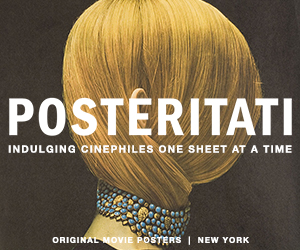Walkabout begins with an extended sequence that can best be described as poetic-didactic.
After opening credits against a series of rocky geological patterns, the camera cuts to a shot of a brick wall. It then slides to the right, revealing the bustling pedestrians and towering buildings of contemporary Sydney, Australia. It’s very modern and busy, yet on the soundtrack we hear aboriginal music—ancient (to Western ears) in its low warblings. After more, nearly abstract shots of legs tramping down city streets, we return to that brick wall, but this time when the camera slides to the right it reveals the barren outback.
Back in Sydney, in a modern condominium, a woman prepares food while a radio program describes a recipe that involves drowning a bird in cognac. As Walkabout settles into its plot, the movie’s aim becomes clear: to function as a mystical juxtaposition of “civilization” and “savagery,” and ask if our definitions of both are simply a matter of perspective.
The plot, which director Nicolas Roeg and screenwriter Edward Bond took from a Donald G. Payne novel, goes on to literalize this notion, as we eventually settle on a teenage girl (Jenny Agutter)—identified only in the credits as Girl—and her younger brother (Luc Roeg, the director’s son)—identified as White Boy—who get lost while on a picnic in the outback. After a few days of desperate wandering, they encounter an aboriginal teen (David Gulpilil)—Black Boy—who hunts and cooks for them while leading them to…?
Roeg worked as a cinematographer before moving into the director’s chair, and much of Walkabout proceeds as pictorial collage: dissolves taking us from a closeup of a lizard to the sandy scales of a topographical ridge; still photos of Black Boy hunting a kangaroo; zooms out from the trio to reveal the vastness of the landscape in which they wander. Along with the music—which, juxtapositionally, occasionally switches to the sound of Girl’s school choir—the movie seems to take place somewhere between a pleasant dream and a nightmare.
I’m not sure where on that scale you’d want to place the film’s increasing interest in sex. Not long after Black Boy appears, he and Girl begin to regard each other with desiring eyes (she fixates on his barely clothed behind while following him on the trail; he notices her pulling back her skirt to examine a scrape she got while climbing a tree). This is somewhat natural for the story, especially one that has elements of a coming-of-age tale, but Walkabout explores its young characters’ sexuality in ways that are increasingly uncomfortable. By the time we get an extended nude scene of Agutter—who was under 18 at the time of filming—as she swims in a watering hole, it’s reasonable to question what kind of movie you’re watching.
Consider, for instance, the fact that Black Boy doesn’t appear to be watching Girl in this scene; it’s only for Roeg (who also serves as cinematographer) and us. We know this because the sequence is oddly intercut with quick shots of Black Boy spearing and bludgeoning animals on a hunt. Intended or not—and I do think the film means for the sequence, with its romantic music, to play as some sort of Edenic, Adam and Eve portrait—such a choice nevertheless also presents Black Boy as a sexual threat, which carries queasy racist implications on top of the sexual ones.
This is also an issue in a later scene in which Girl, who happens to be topless while changing, is approached by Black Boy, who is wearing elaborate body paint and performing an aggressive, ritual dance. Is this another instance of juxtaposition, an attempt to get us to see his movements as no less strange than the customs of Western courtship? (Black Boy does bring flowers.) Perhaps, but Walkabout is confused enough in its presentation to make you wonder if a story of a sexual awakening between a teen girl and an aboriginal boy might have been better told by someone else.



